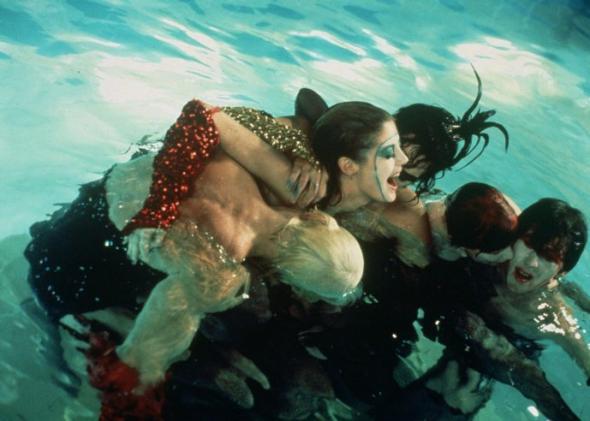It’s Halloween, and Logo, the gay—well, gayish—cable network has a very straightforward schedule: From 10 a.m. Friday through 6 a.m. Saturday, it’s airing The Rocky Horror Picture Show over and over and over again.
Rocky Horror is a fine choice for Halloween entertainment. Apart from anything else, the movie has been one of the richest sources of holiday costume ideas since it came out in 1975. Guys with legs that look good in fishnets can channel Dr. Frank N. Furter; women and drag queens who’ve kept up with their cardio and who live in towns where it’s possible to walk around in bra, panties, and a folded newspaper can be Janet; and the rest of us can pass as unconventional conventioners by donning wacky sunglasses and dancing the Time Warp.
Sartorial fecundity aside, I’ve never been quite sure if the film is good for the gays. Charming and pansexually seductive he may be, but Tim Curry’s Dr. Frank N. Furter is, also an ax-murdering, cannibalistic eugenicist whose forays into the bedrooms of his innocent guests, Brad Majors and Janet Weiss, show a callous disregard for consent.
And yet, in the pre-AIDS days when the movie—and stage show—first appeared, Dr. Furter’s sex-positive (and, yes, murder-cannibalism-positive) message may have helped more people come out of the closet than any other work of art.
Children, when The Rocky Horror Picture Show was first released, there was no streaming video, and although VCRs existed, they were expensive and rare. If you wanted to see this film about two conventional young sheeple having their eyes opened to all the possibilities of absolute pleasure, you had to go to a movie theater and spend two hours in the dark with a bunch of other weirdoes.
Except, of course, that soon after it appeared, Rocky Horror stopped being shown entirely in the dark. Just five months into its run at the Waverly Theatre in New York, people started talking back at the movie, and soon after that, costumed players began to stage parallel performances in front of the screen—in full replica costumes and makeup.
I was a semi-regular at the midnight screenings of Rocky Horror at the State theater in Newark, Delaware, in the early ’80s, and despite the presence of many a heterosexual, it was a very queer scene. Newark is a college town, and at that time it was liberal enough to have a gay student union but conservative enough that identifiable members of that group were liable to be harassed on the street. The folks standing in line outside the State in fishnets and Frank N. Furter makeup every Saturday night undoubtedly widened the sphere of possibilities for gender expression on Main Street. And those midnight performances were as close to a (mostly booze-free) gay bar that Newark had at the time: It was a family. A loose, cliquish one divided into participants and gawkers, to be sure, but a community nonetheless.
At midnight, Logo’s Rocky Horror marathon will start to incorporate some of the classic audience participation elements. Nowadays, you can find cheat sheets online, or buy a DVD that provides onscreen cues when to “snap your RUBBER GLOVES,” but back in the day, people learned when to throw slices of toast into the air and what to yell at the screen after a sort of apprenticeship in the toast-crumb-and-water-pistol-dampened cheap seats.
If you’re watching on Logo, you can fast-forward through the criminologist-narrator’s absurdly slow-paced bits, but don’t under any circumstances miss the swimming pool orgy scene. The mantra “don’t dream it; be it” is one that still applies today.
